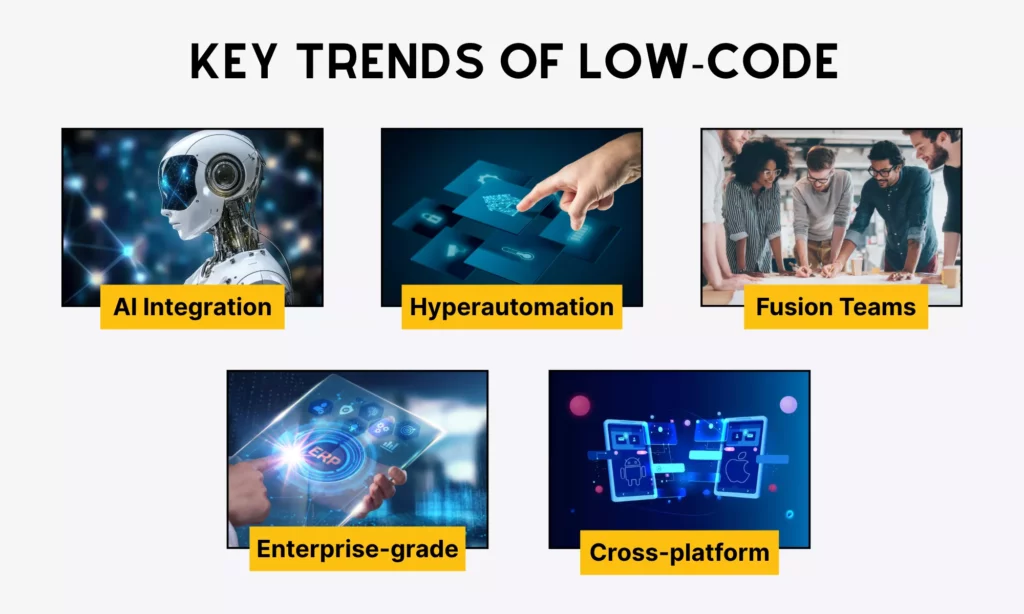Appearing around the 2000s, low-code development has been applied to build simple apps and automate workflows. Decades have passed, and now, low-code has become more powerful thanks to tech advancements. So, will this trend continue, or in other words, what will we expect to see in the future of low-code development?
If you want to answer this question, don’t skip this blog post! Here, we’ll offer you a comprehensive overview of how low-code will look in the future, along with emerging trends, from AI integration to fusion team organization.
Keep reading and prepare for the low-code future! But before diving into these trends, let’s take a quick look at the current statistics about low-code in these years!

Low Code Development Statistics
The following statistics show you how the global market of low-code tools will develop:
- The global low-code market will reach $82.37 billion in 2034. This growth is fueled by the increasing adoption of digital transformation across domains and AI integration into these platforms.
- Gartner predicted that by 2025, 70% of new apps will be developed using low-code or no-code technologies. Accordingly, different departments will create their own solutions instead of distributing development work to separate teams (e.g., for app building, automation, or governance).
- According to KPMG, 81% saw low-code as a crucial strategy.
- The number of citizen developers at large enterprises will be at least fourfold higher than that of professional developers. These business technologists use low-code, no-code, and data analytics tools to build automated processes for their teams.
- According to the Gartner forecast, citizen developers will be the main users (at least 80%) of low-code development platforms. Interest in hyperautomation and composable components helps propel this adoption among non-IT staff.
Low-code platforms bring lots of benefits to businesses. Accordingly, Mendix found that:
- 80% of organizations admitted that low-code makes them more productive.
- 79% said that low-code reduces operational costs.
- 73% reported that low-code increases time to market.
- 44% automates and improves their legacy workflows through low-code platforms.
- 38% said that low-code helps reduce their backlogs.
However, low-code isn’t without limitations. KPMG found that:
- 42% said that security risks are the biggest challenge when adopting low-code platforms. Meanwhile, 41% worried that deploying and maintaining low-code solutions is too complex and that business technologists still lack essential skills to deal with low-code development.
- 43% considered limited customization as another serious challenge.
- 39% cannot adopt low-code for complex situations and said that this development approach lacks transparency for widespread adoption.
Key Trends Shaping the Future of Low-Code
With the given statistics, you can gain a comprehensive overview of how popular low-code is, the benefits it offers, and the challenges impeding its adoption across companies. Along with the growth of low-code, we also witness the emergence of several trends that define its future.

Trend 1: AI and Generative AI integration
The most visible trend is the integration of AI capabilities, especially GenAI, into low-code platforms to augment app creation. With AI, these tools are no longer pure visual builders. Instead, they become intelligent machines.
- Only describing your app idea in plain language, their AI copilots can automatically generate the base structure of screens, workflows, and other UI components without you organizing these elements manually.
- Besides, such AI models as Pega GenAITM Blueprint, Salesforce Einstein, or OutSystems AI Mentor can create code snippets or business logic, recommend integration points or data models, spot bugs, and suggest suitable fixes.
- AI can even automatically generate and run test cases on app features, identify workflow bottlenecks, and recommend solutions.
- It also helps resolve issues associated with project documentation and management. As low-code development handles much of the technical complexity, developers almost don’t document their coding process. This may make new staff onboarding or later reviews more challenging. But AI can automatically write real-time documentation and manage projects better.
- Many low-code platforms also come with AI-driven governance to identify violations, unapproved connectors, or risky permissions. Based on the governance issues it discovered, it accordingly recommends suitable solutions (like role-based access controls or security patches), hence ensuring compliance.
- Many low-code platforms offer app management hubs for your team to track how the app works. With the assistance of AI, this monitoring work becomes more effective. It can predict demands or delays and recommend process improvements.
With AI, you can increase productivity in low-code development. According to Hostinger’s AI research, AI will automate 30% of work hours in the US by 2030. When AI evolves, low-code development will be able to build apps faster and with higher quality.
Trend 2: Hyperautomation
Hyperautomation refers to the practice of automating business workflows as much as possible.
Automation is always one of the key strategic initiatives in many organizations. Dating back to the 1980s, automation was applied to accelerate various business functions at scale, from production planning to HR and accounting.
Today, low-code appears and is considered the backbone of hyperautomation, and in turn, hyperautomation is deemed one of the key drivers behind the growth of low-code platforms.
These tools are used not only to build apps fast, reduce IT backlogs, and remove IT silos. But they also act as a key enabler of enterprise process automation.
Low-code platforms, like Appian or SAP Build, combine visual tools, AI, and even RPA (Robotic Process Automation) to build and trigger automated business workflows. With little or no coding knowledge, you can drag components around and use predefined rules to automate employee onboarding, customer service, or any function you want.
Automation capabilities help save thousands of manual work, especially related to high-volume requests. This improves operational efficiency and reduces costs while ensuring data security and compliance with business standards.
When hyperautomation demands grow, low-code vendors advance their products, so their generated bots can handle more complex requests more precisely.
Trend 3: Fusion Teams
Fusion teams are the combination of IT staff and business stakeholders (e.g., HR representatives, accountants, or marketing executives). They bring technical skills and business knowledge to build a robust app for specific use cases.
To ensure effective collaboration, they need to understand the work of each other. And the advent of low-code platforms has improved this cooperation.
App or bot creation is no longer “IT-only” work. Instead, non-technical users – or citizen developers – can build prototypes and automated workflows using low-code technology.
They don’t need to wait IT staff to deliver every part of digital solutions. But they can actively participate in the development cycle with a shared responsibility.
Meanwhile, developers focus on architecture and governance, guiding business users on how to develop robust, secure, and scalable solutions.
However, according to KMPG, the lack of IT knowledge among non-technical staff is one of the main reasons hindering low-code adoption. Having said that, low-code training is insufficient. Therefore, in the future, to ensure fusion teams work more effectively toward shared goals, targeted training and educational programs are necessary.
Besides, establishing clear low-code governance and guidelines is equally crucial.
KMPG indicated that more than half adopted company-wide guidelines on which apps should be built with low-code. They also define clear security requirements and perform regular audits to ensure that these guidelines are implemented effectively in practice.
More and more companies understand the importance of these guidelines. This encourages them to improve low-code policies and keep everyone in fusion teams on the right track.
Trend 4: Enterprise-grade Low-Code
The future of low-code development is defined by enterprise-driven tools.
Low-code tools now go beyond simple drag-and-drop interfaces. They come with various features and functionalities to serve more complex enterprise needs.
In particular, they have built-in governance and compliance features (e.g., RBAC, audit logs, or centralized governance dashboards) to meet security requirements, especially when you work in regulated industries, like finance, healthcare, and law. They also allow you to integrate with multiple services and systems through prebuilt connectors.
Many low-code platforms, like OutSystems, Appian, or ServiceNow App Engine, support DevOps automation and continuous delivery. Particularly, they integrate with Git, Azure DevOps, and more to handle version control, automated testing, and dependency checks.
Further, apps built with modern low-code platforms can handle growing volumes of requests or transactions and be deployed across regions through the cloud.
When these features are improved in the future, we believe low-code platforms can become powerful tools to handle more enterprise-level use cases.
Trend 5: Cross-platform development
Low-code platforms enable your team to build once and deploy an app on mobile devices (iOS and Android), websites, and desktops.
Particularly, they offer a visual design interface, so you can move UI artifacts and workflows around. These elements can automatically adapt to different screen sizes and operating systems.
Based on your visual designs, low-code platforms can automatically create the corresponding source code, which can run on different platforms.
Further, it enables DevOps pipelines to let your team release updates to many platforms at once.
When the demand for cross-platform development increases, low-code tools may be highly adopted to build and deploy apps faster and at a reduced cost.
Predictions of Low Code Development for the Next 5-10 Years

Low-code platforms, despite some existing limitations, are still expected to thrive in the upcoming five to ten years. Its global value is predicted to reach hundreds of billions of dollars, as an inevitable result of more and more organizations finding faster and smarter ways to build apps.
- Transition from a “tool for citizen developers” to a “core enterprise development strategy”
Initially, low-code platforms were built mainly to serve non-technical users who have no or limited coding knowledge but wish to build apps. These tools help build internal apps and automate business functions.
But now, with AI and enterprise-grade capabilities integrated, these platforms have become a core component of strategic initiatives in many companies. Enterprises are leveraging low-code to save thousands of work hours and boost operational efficiency.
With tech advancements, especially in AI, low-code platforms will become smarter and more effective in designing enterprise-grade systems.
- Increasing role of AI in automating logic, UI, and testing processes
The integration of AI has eased app creation. AI can understand natural language requirements and convert them into functional features or workflows.
Instead of manually writing logic, building UI components, and performing test cases, your team can have AI do these tasks automatically. When AI evolves, its role in low-code development will become increasingly important.
- Low-code won’t replace, but redefine developers
No matter how useful low-code is, it won’t replace professional developers.
Instead, it supports them in every aspect of the development process; further, it reshapes the role of developers, turning them from “pure coders” to “solution designers” or “system architects.”
While letting low-code platforms and business technologists take care of boilerplate work, professional developers focus on designing scalable architectures, integrating AI models and unique systems, and creating highly customized features.
Further, they participate in establishing governance rules and guidelines to ensure seamless collaboration with citizen developers in fusion teams. This ensures low-code solutions align with business requirements in terms of scalability, security, and compliance.
Final Thoughts
This blog post helped you envision which emerging trends are shaping the future of low-code development. They include AI integration, hyperautomation demands, the growth of fusion teams, higher demands for enterprise-grade low-code tools, and cross-platform development.
In the future, we forecast that low-code development platforms, especially when powered by AI, will prove useful in more complex business situations. They will gradually meet the growing demand of enterprises for fast development without compromising quality.
However, no matter how these platforms thrive, the role of developers won’t be underestimated.
Their main responsibility will shift from purely coding to problem-solving. They mainly take on what low-code platforms can’t do, from designing scalable system architectures to conducting complex integrations and governing low-code development.
This shift requires modern developers to upgrade their skills and have good preparation to stay competitive in the AI low-code era.
So, what do you think about the future of low-code development? How will it affect your job?
Share your ideas with us on Facebook, X, and LinkedIn! And don’t forget to subscribe to our blog and receive the latest news!


